
Guests
- Steve Fraserauthor, editor and labor historian. His many publications include the award-winning book Labor Will Rule: Sidney Hillman and the Rise of American Labor. The book won the Philip Taft Prize for the best book in labor history. Fraser currently teaches at New York University.
- Annelise Orleckprofessor at Darmouth College and author of the book Common Sense and a Little Fire: Working Class Women’s Activism in the 20th Century U.S.
The 1911 Triangle Shirtwaist Factory fire in New York City unleashed public outrage, forcing government action. Within three years, more than 36 new state laws had been passed on quality of workplace conditions. The landmark legislation gave New Yorkers the most comprehensive workplace safety laws in the country and become a model for the nation. “There’s a straight line, really, that runs from the fire right through to the New Deal, the labor legislation reform of that era, the welfare state, and the creation of industrial unionism, and the right to organize in the 1930s,” says labor historian Steve Fraser. [includes rush transcript]
Transcript
JUAN GONZALEZ: The Triangle Shirtwaist Factory fire unleashed public outrage and forced government action. Within three years, more than 36 new state laws had been passed on quality of workplace conditions. The landmark legislation gave New Yorkers the most comprehensive workplace safety laws in the country and became a model for the nation.
AMY GOODMAN: Today, events and processions are planned across New York City and across the country to mark this historic anniversary.
We’re joined here in the studio by three guests. We’re beginning with Steve Fraser, author, editor, historian of labor. Fraser’s many publications include the award-winning book Labor Will Rule: Sidney Hillman and the Rise of American Labor. The book won the Philip Taft Prize for the best book in labor history. He currently teaches at New York University.
Talk about the significance of this fire today, exactly how it happened and what it launched.
STEVE FRASER: Well, the fire — there’s a straight line, really, that runs from the fire right through to the New Deal, the labor legislation reform of that era, the welfare state, and the creation of industrial unionism and the right to organize in the 1930s. And there’s a line that runs from that period to our current moment, which is determined, in part, by an assault on all of those democratic achievements that we see going on in Madison, Wisconsin, throughout the industrial Midwest, even bizarrely in Maine, where the governor of Maine has actually proposed erasing that history by obliterating the names of some of the heroines that organized the garment industry and were present at the fire — Rose Schneiderman, particularly, who was a key militant, a member of the Women’s Trade Union League, and of course Frances Perkins, who became — who was a witness to the fire and became Roosevelt’s Secretary of Labor. There are conference rooms in Augusta named after those two women, who the current Republican governor proposes to remove, because he considers those names not neutral enough. So there’s a — we’re living that history even today.
AMY GOODMAN: We’re going to go back in time just after break, and then we’re going to come forward to look at what this means in this country and around the world. This is Democracy Now!, democracynow.org, The War and Peace Report. Today, a Democracy Now! special, on this hundredth anniversary of the Triangle Shirtwaist Factory fire.
[break]
AMY GOODMAN: “Ballad of the Triangle Shirtwaist Factory Fire” by Bev Grant, on this hundredth anniversary of the fire that took the lives of 146 workers, just down the road from where we’re sitting today in New York. I’m Amy Goodman, with Juan Gonzalez. This is Democracy Now! […]
Our guest, Steve Fraser, an author, editor, historian of labor. Among his many publications, the award-winning book Labor Will Rule: Sidney Hillman and the Rise of American Labor.
We are also joined by Annelise Orleck. She’s a professor of history at Dartmouth College, author of Common Sense and a Little Fire: Working Class Women’s Activism in the 20th Century U.S.
And Charles Kernaghan is the director of the Institute for Global Labour and Human Rights, formerly the National Labor Committee.
Juan?
JUAN GONZALEZ: Well, Steve, before the break, we were talking about the straight line from that fire to today. But I’d like to also go back a year before the fire, because there was a huge — as we mentioned in the lede, a huge and important strike of thousands of garment workers, largely women, that really had a major impact, and then several of the — and the Shirtwaist Factory fire workers were part of that movement. Could you talk about that strike and its importance?
STEVE FRASER: Yes, that’s known — was known then, and has been known since, as “the Uprising of the 20,000.” And in fact there were probably well more than 20,000 garment workers, largely women garment workers, involved in that strike, which broke out in 1909. And actually, the 1909 strike is itself the culmination of a chronic series of strikes in the garment industry stemming way back into the 1890s, in protest against the miserable conditions of work, the low wages, child labor, the lack of any sanitary or health protections. Fires were common. They had occurred in the Triangle Shirtwaist Factory before the tragedy of 1911.
And so, there was an ongoing process of trying to organize the industry, unionize the industry, which comes to a head in 1909, and enlists the sympathies of a broad spectrum of middle-class New Yorkers, as well, particularly the Women’s Trade Union League, the Consumers League, women from the suffrage movement, who become involved in assisting the strikers, appearing on the picket lines, bailing them out of jail, trying to bring publicity to what’s going on as the police attack the strikers, judges throw them in jail and so on. And so, it’s a monumental movement, and a partly successful one, successful insofar as the industry is compelled to improve some of the conditions of work, but not a victory insofar as there’s no blanket recognition of the union emerging out of that strike.
JUAN GONZALEZ: And, of course, that’s —
STEVE FRASER: And certainly, not at Triangle then.
JUAN GONZALEZ: And that’s the lesson for today, because, really, without the union recognition and the right to collectively bargain your conditions of work, the workers had no say over what was —
STEVE FRASER: That’s exactly right.
JUAN GONZALEZ: — how the factory was operated.
STEVE FRASER: Yes, without that power, you are always in jeopardy of losing whatever temporary gains you’ve won.
AMY GOODMAN: Annelise Orleck, explain what happened on that fateful day, on March 25th, 1911. Why were these workers locked out and in?
ANNELISE ORLECK: Well, the owners of the Triangle company, Harris and Blanck, claimed that they a problem with theft, and so they locked the door out of which most of the workers left to prevent — supposedly to prevent them from taking fabric and stealing from the company. Afterwards, when it came to trial, the owners admitted that the most they might possibly have lost was $15, $20 a year. So, that’s the number that ultimately cost all of those workers’ lives.
There were “no smoking” signs in the factory, but the cutters, who were kind of the elite in the shop, were known to ignore that, and perhaps one of them did. It’s not clear exactly what happened. But someone flicked an ash, and it caught in what was probably more than a ton of fabric scraps. There had been more than 100,000 shirtwaists made since the last time the manufacturers had cleaned scraps out of the shop. And the young women — it’s worth picking up on what Steve said — had been warning about those scraps. They had been warning about them for months. There were hundreds of complaints on file at the Women’s Trade Union League about the dangers of these factories and the likelihood that fire would start. And indeed, there had been a lethal fire in Newark, just a few months before the Triangle fire, that killed 26 young women and injured many others. So they were aware of this danger.
And what happened was even worse than they could have predicted. The fire spread through the grass linen out of which the fabric — out of which the shirtwaists were made. It was very flammable. And it spread so quickly and so horribly and with so much heat that there were actually skeletons of young women at their sewing machines, who were discovered after the fire. So some never made it away from their desks.
Others tried to leave. There were two doors to the factory. One was blocked by flames, the other one was probably locked. And that was the reason that so many were left with the horrible choice of either being — of perishing in fire or jumping out the window. Some of them rushed out onto the fire escape, about 25 of them. There were already people from the eighth floor on the fire escape. It collapsed. And that was the first terrible scene of death that New Yorkers witnessed from below.
But in a way, even more awful, if — you can’t judge these things, but — was this revelation that Frances Perkins later described, that what at first appeared to be fabric that the manufacturers were throwing out the window — people thought they were trying to save their good fabric — people soon realized were workers, young women, a few young men. And within a half-hour, many hundreds, if not thousands, on the street below had watched this carnage and really vividly experienced the terror.
In the aftermath, they experienced a different kind of terror, which was that the bodies of the young workers lay on the streets for several days as New Yorkers came by to try to identify their loved ones. And that makeshift morgue almost made the whole city feel like a makeshift morgue. Eventually it was moved to the 26th Street Pier. And again, for days, New Yorkers were treated to images of family members grieving, collapsing, coming out from having tried to identify their lost loved ones.
AMY GOODMAN: And who these women were?
ANNELISE ORLECK: Well, I think that’s the most important thing to remember, because there have been so many tragedies in the 20th century, the question is always: why has this one attracted so much attention? Why does it still move so many people?
These women were the strikers of 1909, 1910, and they had gotten a lot of coverage in the press. And they had been quoted, sometimes 15-, 16-, 17-year-old girls talking about their constitutional rights and their rights to picket without being beaten and marching on City Hall with banners in Yiddish and Italian and English, saying, “We are not slaves” and “Abolish slavery.”
And they were saucy. The management had attempted to put prostitutes on the line to sully the reputations of these girls. And instead of them saying, “Oh, no, no, no. We’re not prostitutes. Don’t mistake us,” they said, “Better to be a streetwalker than a scab. It’s an honest profession.”
So they had attracted the attention and the affection of the city. And as Steve pointed out, many people who had not previously been sympathetic to labor began to shift their views. Even the New York Times, which had been staunchly anti-labor, began to cover the strikers with a little bit more sympathy. Partly it was the violence that was leveled against them. The leader of the strike, Clara Lemlich, had six ribs broken by clubs during the course of the strike. There were girls who were dragged off with bloodied heads in bandages. And at first that didn’t win sympathy. One judge, when a girl was dragged before him with a head covered in blood, said, “You are on strike against God and nature, and women shouldn’t be out parading themselves like this.”
JUAN GONZALEZ: And what happened to the two owners of the factory, and what kind of penalties did they receive?
ANNELISE ORLECK: The trial was an interesting trial, because it’s the flip side of the kind of heroic imagery that you saw of these young women before the fire, during the strike. The trial was really an exercise in putting them on trial, in a sense. They were described as prone to panic, hysterical. Their deaths were basically attributed to that hysteria and that panic. It was said that they had rushed to the door and blocked the door, and that’s why —
AMY GOODMAN: Who were they?
ANNELISE ORLECK: Hmm?
AMY GOODMAN: Who were they?
ANNELISE ORLECK: Who were the girls?
AMY GOODMAN: The workers — the owners.
ANNELISE ORLECK: Harris and Blanck, Isaac Harris and Max Blanck. They were German Jews. They had been in the country a little while longer than the workers, which was typical of these garment shops, although this one was bigger. They certainly had more capital to invest than, you know, the owners of little sweatshops, which were kind of fly by night, rented by the week. But that said, they still had family working in the shops. They lost family in the shops, and they lost family in the fire. So, they were not completely removed from the garment trade themselves. Nevertheless, they hired a very flashy New York attorney, Max Stoyer, who was one of these celebrity defense attorneys. And he —
JUAN GONZALEZ: And he attempted to blame the victims for panicking?
ANNELISE ORLECK: He did. And he accused them of perjury. You know, he soft-pedaled it. He said they couldn’t remember, maybe. They were so hysterical that they couldn’t remember what had happened to them. He brought on a wave of witnesses who had worked with the company at different times and said they had seen the door open — not that day, but that they had come in and out of the door. And one juror later said they believed the door was locked, but the defense attorney had introduced enough reasonable doubt. And interestingly enough, even the prosecutor called the girls less intelligent than the norm.
AMY GOODMAN: I want to go to someone you just mentioned: Frances Perkins. This really launched her. One of the witnesses of the Triangle fire’s deadly impact was Frances Perkins, the future Secretary of Labor for President Franklin Delano Roosevelt. At the time, she was 30 years old. Perkins said the fire was, quote, “a never-to-be-forgotten reminder of why I had to spend my life fighting conditions that could permit such a tragedy.” I want to go to a clip from 1964 of Frances Perkins talking about the Triangle Shirtwaist Factory fire.
FRANCES PERKINS: Everybody who jumped — and a good many did jump from the ninth and 10th floors — was killed. And the other people who died were all people who were burned or smothered by the smoke in the factory itself.
This made a terrible impression on the people of the state of New York. I can’t begin to tell you how disturbed the people were everywhere. It was as though we had all done something wrong. It shouldn’t have been. We were sorry. Mea culpa, mea culpa. We didn’t want it that way; we hadn’t intended to have 147 girls and boys killed in a factory. It was a terrible — it was a terrible thing for the people of the City of New York and the state of New York to face.
I remember that Al Smith — the action happened on a Saturday. I happened to have been visiting a friend in the park on the other side of the park, and we heard the engines, and we heard the screams and rushed out and rushed over where we could see the trouble was. We could this building from Washington Square, and the people had just begun to jump when we got there. They had been holding until that time, standing in the windowsills, crowding, being crowded by others behind them, and the fire pressing closer and closer, the smoke closer and closer.
Finally, the men were trying to put up — trying to get out this thing that the firemen carry with them, a net, to catch people if they do jump. And they were trying to get that out, and they couldn’t wait any longer. I mean, they began to jump. This is when the window was too crowded, and they were jumping. They hit the sidewalk. The net broke. It was a terrible distance, and the weight of the bodies was so great at the speed at which they were traveling that they broke through the net. And every one of them was killed. Everybody who jumped was killed. And it was a horrifying spectacle.
AMY GOODMAN: That was Frances Perkins in 1964. Well, Kirstin Downey wrote a book about Frances Perkins called The Woman Behind the New Deal: The Life of Frances Perkins, FDR’s Secretary of Labor and His Moral Conscience. And in 2009, I asked her to talk about Frances Perkins and the Triangle Shirtwaist Factory fire, how it really helped to shape the New Deal.
KIRSTIN DOWNEY: I was very taken by the fact that this young woman — she was only 30 years old when she saw the fire — witnessed a terrible spectacle. Now, thousands of people were dying in workplace fires all over the country at that time, but this particular fire is viewed by a lot of New Yorkers, but it’s also viewed by this very dynamic young woman. She decides — it galvanizes her. She says this has to change.
She’s a descendant of Revolutionary War patriots. She has a great sense of moral responsibility for the country being the kind of place that it should be. And she thinks that what’s happening to these factory workers is just wrong.
Teddy Roosevelt selects her to be executive director of the — executive secretary of the Committee on Safety. And I found that in documents at the Library of Congress. Even a lot of Teddy Roosevelt scholars didn’t know that. And she leads the charge. She does it in her characteristic way of making alliances with unlikely partners. You see her, of course, gathering all the idealists together, all the people that she describes as looking in shock and terror, but she also finds ways to reach out to the insurance companies to convince them that fire hazards are something that they should be considering a financial issue. She gets insurance company executives to talk to real estate owners.
And she is instrumental in creating a legislative committee in the state of New York that holds fact-finding hearings all around the state to discuss hazards of all kinds. Out of that comes much legislation and things that have had effects on all of us today: occupancy limitations, fire exits, even removing trash, flammable trash, every night from workplaces. These all came from Frances Perkins’s work in New York at that time.
AMY GOODMAN: That was Kirstin Downey, author of The Woman Behind the New Deal: The Life of Frances Perkins, FDR’s Secretary of Labor and His Moral Conscience. That’s where we’re going now: FDR.
JUAN GONZALEZ: Yeah, Steve, what about that? What about her impact on all of the legislation that occurred during the Roosevelt era that really was the heyday of rights, really, for the American worker?
STEVE FRASER: Yeah, exactly right. Frances Perkins is probably the greatest Secretary of Labor we’ve ever had, and she deserves a great deal of the credit. And the inspiration comes from these women who died that day.
But I must say that there would be no New Deal legislation, there wouldn’t be a Fair Labor Standards Act passed in 1938, establishing minimum wages and maximum hours, abolishing child labor, there wouldn’t have been a Wagner Act, ensuring the right to collective bargaining, there wouldn’t have been Social Security and unemployment insurance and welfare, had not the garment unions emerged out of this fire and strike and produced what was called, in the 1920s, the New Unionism, which prefigured all of the New Deal, a unionism which fought for health insurance, unemployment insurance, low-cost cooperative housing, built a multi-ethnic, multi-religious industrial union. And without the industrial unions of the 1930s, the CIO, it’s hard to conceive that Roosevelt and Frances Perkins, despite their good intentions and indefatigable labors, would have achieved what they had achieved. And that’s why I think today we need to commemorate, but also celebrate, in an odd sort of way, these women. They died, and they died — and, by dying, achieved this kind of industrial democracy, which, without what they had been involved in, wouldn’t have happened.
AMY GOODMAN: We’re going to continue this discussion after break. Charles sic. Fraser teaches at New York University, Annelise Orleck at Dartmouth — Steve Fraser.
STEVE FRASER: OK.
AMY GOODMAN: Annelise Orleck, who, by the way — whose grandmother worked at the Triangle Shirtwaist Factory fire. Annelise is a historian at Dartmouth College. And we’ll also be joined by Charles Kernaghan after break, the director of the Institute for Global Labour and Human Rights, to talk about where we are today, how we can be showing today a video of another fire that took place just a few months ago, workers in Bangladesh jumping to their deaths as they were trying to make clothes for U.S. companies. This is Democracy Now! Stay with us.

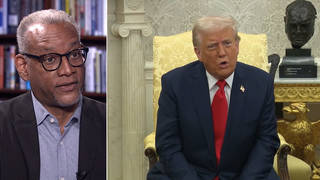
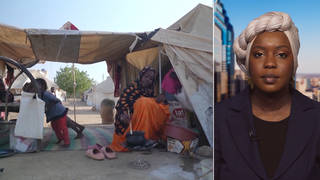

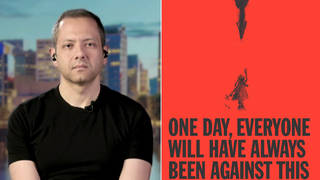


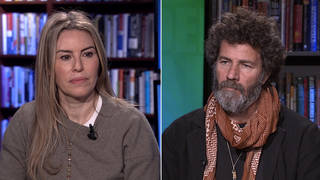
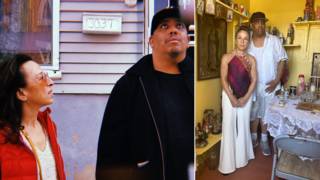

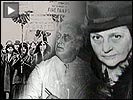

Media Options